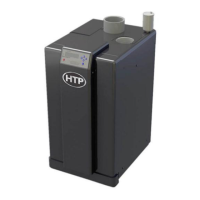41
LP-387 REV. 12.15.14
b. For example: If the 3” exhaust vent has two short 90
o
elbows and
10 feet of PVC pipe we will calculate: Exhaust Vent Equivalent Length
= (2x5) + 10 = 20 feet.
Further, if the 3” intake pipe has two short 90
o
elbows, one 45
o
elbow,
and 10 feet of PVC pipe, the following calculation applies: Intake Pipe
Equivalent Length = (2x5) + 3 + 10 = 23 feet.
The Exhaust Vent Equivalent Length + the Intake Pipe Equivalent
Length equal the Total Equivalent Length. In this example, the Total
Equivalent Length is 43 feet.
c. The minimum Total Equivalent Length is 15 feet.
F. LONGER VENT RUNS
The maximum total equivalent length can be extended by equally increasing the diameter of both the exhaust vent and intake pipes.
However, the transitions should begin a minimum of 16 total equivalent feet from the boiler.
On all units EXCEPT the EFT-285, maximum equivalent length for increased diameter vent pipes is 275 ft, which includes the 16 ft from
the boiler with a transition total of 259 ft upsize piping for longer vent runs (234 ft for the EFT-285). On the EFT-285, the maximum
equivalent length for increased diameter vent pipes is 250 ft., which includes the 16 ft from the boiler with a transition total of 234 ft
upsize piping for longer vent runs.
Table 12
Do not exceed the maximum lengths for increased diameter vent pipes. Excessive length could result in appliance shutdown and
property damage.
G. EXHAUST VENT AND INTAKE PIPE INSTALLATION
All joints of positive pressure vent systems must be sealed completely to prevent leakage of flue products into living space.
1. Use only solid PVC or CPVC pipe, AL29-4C Stainless Steel, or a Polypropylene vent system, approved for use with Category IV
boilers.
FOAM CORE PIPING IS NOT APPROVED FOR EXHAUST APPLICATIONS. Foam core piping may be used on air inlet piping only.
2. Remove all burrs and debris from joints and fittings.
3. When using PVC or CPVC pipe, all joints must be properly cleaned, primed, and cemented. Use only cement and primer approved
for use with the pipe material. Cement must conform to ASTM D2564 for PVC and ASTM F493 for CPVC pipe. NOTE: DO NOT
CEMENT POLYPROPYLENE PIPE.
4. Ensure the vent is located where it will not be exposed to prevailing winds.
5. In all roof venting applications, exhaust discharge must point away from the pitch of the roof.
6. To prevent water leakage, install adequate roof flashing where the pipe enters the roof.
7. Do not locate vent over public walkways, driveways, or parking lots. Condensate could drip and freeze, resulting in a slip hazard or
damage to vehicles and machinery.
8. Due to potential moisture build-up, sidewall venting may not be the preferred venting option. To save time and cost, carefully
consider venting installation and location.
9. Horizontal lengths of exhaust vent must slope back towards the boiler not less than ¼" per foot to allow condensate to drain from the
vent pipe.

